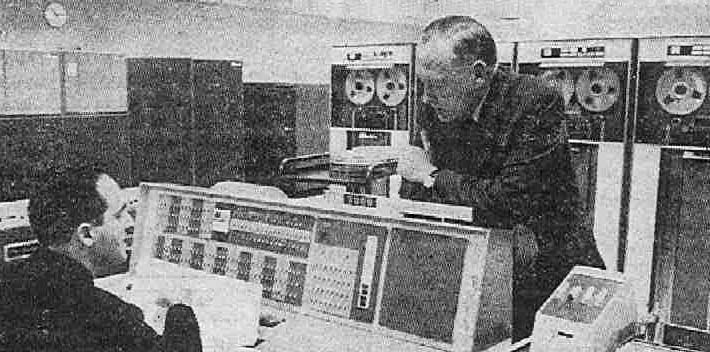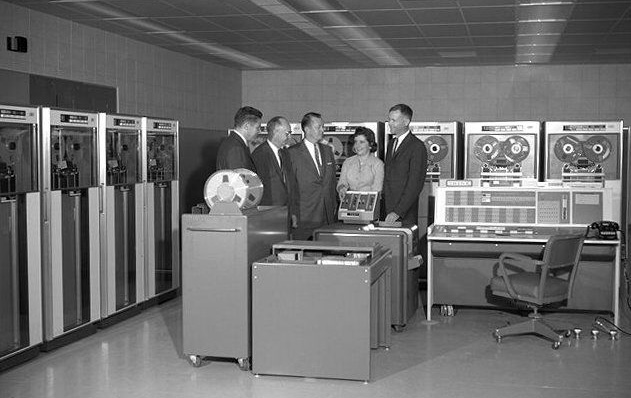Columbia University Machine Room 1965 Photo Gallery
Nine high-quality photos, four of them of the 7090.
The IBM 7090, announced in 1958, was a transistorized version of the vacuum-tube-logic 709 and the first commercial computer with transistor logic (the first such computing device, according to [53], was the IBM 608, but that was not a general-purpose stored-program computer). The 7090, like the 700 series it superseded, was intended mainly for scientific computing, but it was also suitable for business and administrative use. Its IBSYS operating system was tape-based; it required 8 magnetic tape drives run and had to be booted from the card reader.
Columbia's 7090 was installed in 1963; by 1966 it had been upgraded to a bigger and faster 7094 and coupled with a 7040 to form the 7094/7040 Directly Coupled System, which would remain in place until 1968, when it was replaced by the IBM 360/91.

Grayson Kirk, President of Columbia University (right) and Kenneth M. King, director of the University's new Computer Center, 1963, in the machine room at the IBM 7090 console of "one of the largest computers in existence" at the time.

The IBM 7090 Console in the Columbia Computer Center machine room, 1966. Pictured: A group of particle physicists who discovered the violation of charge-conjugation invariance in interactions of intermediate strength: Charles Baltay and Lawrence Kirsch of Nevis Lab (back row); Juliet Lee-Franzini of SUNY Stony Brook and team leader Paulo Franzini of Nevis Lab [V1#7].

From Mike Radow, formerly of Watson Lab:
There was also a 7090 in the Interchurch Center, on Riverside Drive and 120th Street, by 1959 or 1960. Strictly speaking, this was not a Columbia machine, but belonged to NASA. However, it often had unused capacity and was heavily used by Columbia researchers, many of whom had joint CU / NASA appointments. I programmed numerous large Fortran programs for Professor Leonard Nanis, who studied how metal alloys mixed under the extremes of either "perfect stirring" or "pure diffusion". For me, this 7090 was the first time I ever ran on a machine which had any form of an OS, although its IBSYS and IBJOB made DOS 3.0 look good!In the early 60's, Interchurch needed the 7090's space and it was removed. NASA consolidated to its current über-Seinfeld digs, by moving their computing facility over Tom's restaurant. For a while, I programmed their IBM 360/95 in this space, on Broadway and 112th Street. It ran only a highly-modified Fortran on a modified OS, which I think — but am not sure — was derived from OS/MFT. Later, NASA got one of the very first Amdahls to be shipped. It was a pretty good match for 95's speed, but there was a disappointing lack of blinking lights. Users included — and still included — many NASA researchers who also have some form of a CU affiliation.
The IBM 7090 is featured in the 2017 film Hidden Figures, about the unsung role played by Black women in the early NASA space program. I suspect it's a full-size mockup.
- 7090 Data Processing System (IBM)
- 7094 Data Processing System (IBM)
- IBM 7090/94 Architecture (Frobenius)
Translations of this page courtesy of...
| Language | Link | Date | Translator | Organization |
|---|---|---|---|---|
| Belarusian | Беларуская | 2023/08/22 | Vladyslav Byshuk | Владислав Бишук | studycrumb.com |
| Finnish | Suomi | 2023/08/31 | Kerstin Schmidt | writemyessay4me.org |
| French | Français | 2023/08/25 | Kerstin Schmidt | prothesiswriter.com |
| German | Deutsch | 2023/08/25 | Kerstin Schmidt | writemypaper4me.org |
| Italian | Italiano | 2023/08/31 | Kerstin Schmidt | admission-writer.com |
| Polish | Polski | 2023/08/25 | Kerstin Schmidt | justdomyhomework.com |
| Russian | Русский | 2023-07-16 | Alexey | Plastic Recycling Company |
| Slovak | Slovenčina | 2023/08/22 | Vladyslav Byshuk | Владислав Бишук | studybounty.com |
| Spanish | Español | 2023/08/31 | Chema Bescos | Traducciones Barcelona |
| Ukrainian | Українська | 2023/08/22 | Vladyslav Byshuk | Владислав Бишук | skyclinic.ua |